If this product has an expiration or retest date, it will be shown on the Certificate of Analysis (COA, CofA). If there is no retest or expiration date listed on the product's COA, we do not have suitable stability data to determine a shelf life. For these products, the only date on the COA will be the release date; a retest, expiration, or use-by-date will not be displayed.
For all products, we recommend handling per defined conditions as printed in our product literature and website product descriptions. We recommend that products should be routinely inspected by customers to ensure they perform as expected.
For products without retest or expiration dates, our standard warranty of 1 year from the date of shipment is applicable.
For more information, please refer to the Product Dating Information document: https://www.sigmaaldrich.com/deepweb/assets/sigmaaldrich/marketing/global/documents/449/386/product-dating-information-mk.pdf
About This Item
推荐产品
品質等級
化驗
≥95% (HPLC)
形狀
powder or crystals
顏色
Reddish-brown
pKa
1.7 (4-hydroxyl group)
7.9 (4-piperazine nitrogen)
pI
4.84
抗生素活性譜
Gram-negative bacteria
Gram-positive bacteria
mycobacteria
viruses
作用方式
protein synthesis | interferes
儲存溫度
−20°C
SMILES 字串
CO[C@H]1\C=C\O[C@@]2(C)Oc3c(C)c(O)c4c(O)c(NC(=O)C(C)=C\C=C\[C@H](C)[C@H](O)[C@@H](C)[C@@H](O)[C@@H](C)[C@H](OC(C)=O)[C@@H]1C)c(\C=N\N5CCN(C)CC5)c(O)c4c3C2=O
InChI
1S/C43H58N4O12/c1-21-12-11-13-22(2)42(55)45-33-28(20-44-47-17-15-46(9)16-18-47)37(52)30-31(38(33)53)36(51)26(6)40-32(30)41(54)43(8,59-40)57-19-14-29(56-10)23(3)39(58-27(7)48)25(5)35(50)24(4)34(21)49/h11-14,19-21,23-25,29,34-35,39,49-53H,15-18H2,1-10H3,(H,45,55)/b12-11+,19-14+,22-13-,44-20+/t21-,23+,24+,25+,29-,34-,35+,39+,43-/m0/s1
InChI 密鑰
JQXXHWHPUNPDRT-WLSIYKJHSA-N
正在寻找类似产品? 访问 产品对比指南
相关类别
訊號詞
Warning
危險聲明
危險分類
Acute Tox. 4 Oral
儲存類別代碼
11 - Combustible Solids
水污染物質分類(WGK)
WGK 1
閃點(°F)
Not applicable
閃點(°C)
Not applicable
個人防護裝備
dust mask type N95 (US), Eyeshields, Gloves
历史批次信息供参考:
分析证书(COA)
其他客户在看
商品
Discover critical characteristics to consider when working with enzyme inhibitors, such as cell permeability, the prozone effect, and Lipinski’s rule of 5.
Discover critical characteristics to consider when working with enzyme inhibitors, such as cell permeability, the prozone effect, and Lipinski’s rule of 5.
Discover critical characteristics to consider when working with enzyme inhibitors, such as cell permeability, the prozone effect, and Lipinski’s rule of 5.
Discover critical characteristics to consider when working with enzyme inhibitors, such as cell permeability, the prozone effect, and Lipinski’s rule of 5.
-
How can I determine the shelf life / expiration / retest date of this product?
1 answer-
Helpful?
-
-
How is shipping temperature determined? And how is it related to the product storage temperature?
1 answer-
Products may be shipped at a different temperature than the recommended long-term storage temperature. If the product quality is sensitive to short-term exposure to conditions other than the recommended long-term storage, it will be shipped on wet or dry-ice. If the product quality is NOT affected by short-term exposure to conditions other than the recommended long-term storage, it will be shipped at ambient temperature. As shipping routes are configured for minimum transit times, shipping at ambient temperature helps control shipping costs for our customers. For more information, please refer to the Storage and Transport Conditions document: https://www.sigmaaldrich.com/deepweb/assets/sigmaaldrich/marketing/global/documents/316/622/storage-transport-conditions-mk.pdf
Helpful?
-
-
What solvent should be used to reconstitute item R3501, Rifampicin?
1 answer-
Rifampicin is soluble in CHCl3. Additionally, it is soluble in water at pH 4.3 (1.3 mg/ml), methanol (25 mg/ml), DMSO (25 mg/ml), dimethyl sulfoxide, tetrahydrofuran, and water at pH 7.3 (2.5 mg/ml at 25°C).
Helpful?
-
-
What is the difference between the various Rifampicin products available from Sigma-Aldrich?
1 answer-
Sigma-Aldrich offers several Rifampicin products, each tested and best suited for specific applications. The products range from a general use research grade to sterile powder, to plant culture tested. See individual products for specific details.
Helpful?
-
-
How is the potency determined for Product R3501, Rifampicin?
1 answer-
The potency is determined from a microbiological assay (USP XXII) for antibiotics, a 2-level assay. The test organism is Bacillus subtilis ATCC 6633. The minimum dose is 4.0 μg/ml and the maximum dose is 8.0 μg/ml.
Helpful?
-
-
The label advises that I should store Product R3501, Rifampicin, frozen. But when it arrived there was no ice in the package. Why is that?
1 answer-
This product in its powder form is stable for short periods of time (i.e., the shipping process), at ambient temperature. For long term storage it is best to store it at -20°C.
Helpful?
-
-
What is the Department of Transportation shipping information for this product?
1 answer-
Transportation information can be found in Section 14 of the product's (M)SDS.To access the shipping information for this material, use the link on the product detail page for the product.
Helpful?
-
Active Filters
我们的科学家团队拥有各种研究领域经验,包括生命科学、材料科学、化学合成、色谱、分析及许多其他领域.
联系技术服务部门












